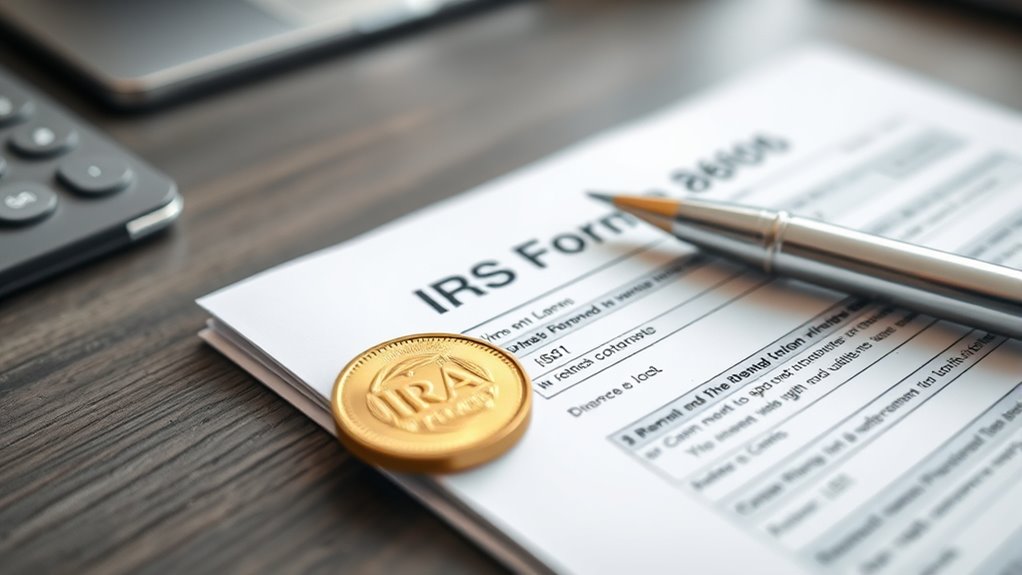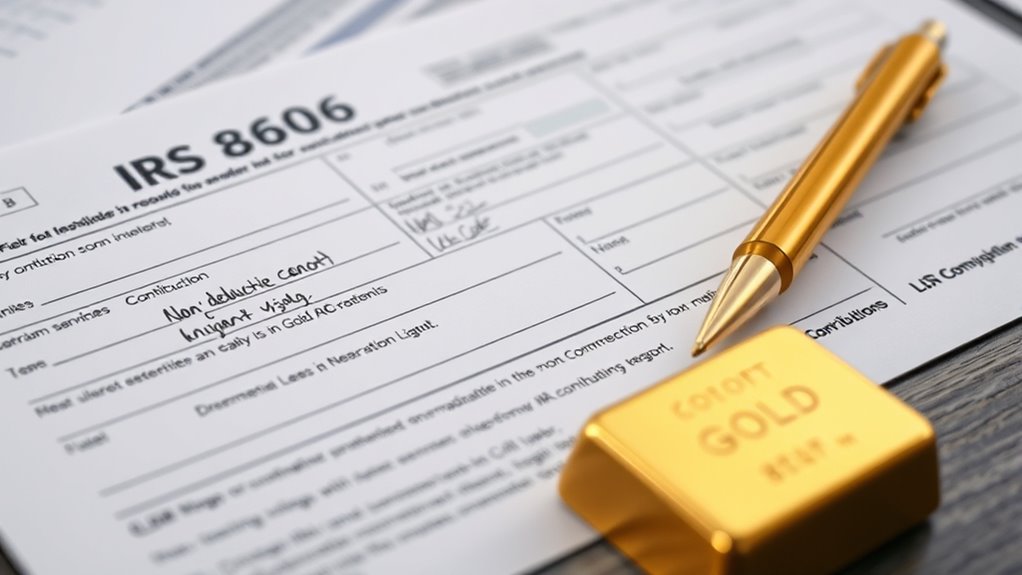To correctly report non-deductible Gold IRA contributions, you need to complete IRS Form 8606 each year you make these contributions or take distributions. This form tracks your after-tax investments, helping prevent double taxation and ensuring your records match your tax filings. Accurately filling out Form 8606 is essential for IRS compliance and avoiding penalties. If you keep going, you’ll discover the detailed steps to report contributions, distributions, and conversions effectively.
Key Takeaways
- IRS Form 8606 reports nondeductible contributions to traditional IRAs, including gold IRAs, ensuring proper tax treatment.
- Properly completing Form 8606 tracks your after-tax gold IRA contributions, preventing double taxation on future distributions.
- The form prorates taxable and nontaxable amounts during gold IRA distributions, ensuring accurate reporting of gains and basis.
- Use Form 8606 to document conversions from traditional to Roth IRAs involving gold assets, avoiding double taxation.
- Maintain accurate records of your nondeductible gold IRA contributions and filings to ensure compliance and correct future tax calculations.

Are you aware of how to properly report nondeductible contributions and distributions from your IRAs? If not, understanding IRS Form 8606 is essential for staying compliant and accurately tracking your IRA transactions. This form serves as the primary tool for reporting nondeductible contributions to traditional IRAs and for documenting distributions that involve these contributions. When you make nondeductible contributions—often with after-tax dollars—you need to file Form 8606 each year you contribute or take a distribution, ensuring your basis is correctly recorded for future tax calculations. Failing to do so can lead to costly mistakes, including paying taxes twice on the same funds or facing penalties for incorrect reporting. Keep copies of the form for your records, as they can be crucial during audits or when calculating your taxes.
Reporting nondeductible contributions involves more than just noting the amount. The form helps you establish your basis, which is the portion of your IRA that has already been taxed. This tracking is essential because, when you withdraw money, the IRS needs to know how much of the distribution is taxable. If you don’t keep an accurate record of your nondeductible contributions, you risk overpaying taxes or facing penalties for improper reporting. The form also covers traditional IRA distributions, requiring you to report any withdrawals where nondeductible contributions exist. This ensures that your distributions are prorated between taxable and nontaxable amounts, based on your accumulated basis. Because calculations can be complex, especially with multiple contributions and distributions over time, meticulous record-keeping and accurate completion of Form 8606 are indispensable. Proper understanding of tax basis tracking helps prevent errors that could lead to double taxation or penalties.
Tracking nondeductible IRA contributions is vital for accurate tax reporting and avoiding penalties.
The form is also used for Roth IRA transactions, particularly conversions from traditional IRAs. When you convert funds, you must report the conversion amount, and if you make early distributions from a Roth IRA—before age 59.5 or before five years from the account opening—you need to disclose these as well. Proper reporting helps avoid penalties and clarifies whether your distribution qualifies for tax-free treatment. For inherited IRAs, including traditional and Roth accounts, Form 8606 may be necessary if distributions have a basis or are non-qualified, ensuring you’re accurately reporting the tax implications involved. Additionally, the IRS requires accurate reporting to prevent double taxation, especially during conversions or rollovers. Understanding the complex rules surrounding IRA transactions can be daunting, but proper reporting simplifies your tax situation. Being aware of the IRA transaction rules is vital for maintaining compliance and optimizing your tax outcomes.
In addition, the form plays a role in transfer and conversion rules, especially during IRA rollovers or conversions to Roth accounts. Accurate completion is essential because the IRS relies on this information to determine your tax liability. Understanding the importance of proper reporting can help you avoid penalties, interest, and unnecessary complications. Misreporting or neglecting to file when required can lead to penalties, interest, and unnecessary complications. By understanding the importance of IRS Form 8606 and diligently reporting nondeductible contributions and distributions, you can manage your IRA effectively, minimize taxes owed, and stay compliant with IRS regulations.
Frequently Asked Questions
Can I File Form 8606 Electronically?
Yes, you can file Form 8606 electronically. Most tax software programs support electronic filing and guide you through entering the necessary information accurately. When you file electronically, you’ll need to provide your digital signature, and the software will check for errors in real-time. This method is faster, more convenient, and reduces the chance of mistakes, ensuring your nondeductible IRA contributions and other details are reported correctly.
What Are the Penalties for Incorrect Reporting?
They say “better safe than sorry,” and that’s true with IRS reporting too. If you file incorrectly, you could face $50 penalties per missed form, double taxation during Roth conversions, and IRS scrutiny. Missing or late filings complicate things further, leading to costly corrections. To avoid this, keep detailed records, file Form 8606 annually, and seek professional help if needed. Staying compliant protects your investments and peace of mind.
How Do I Amend a Previously Filed Form 8606?
To amend a previously filed Form 8606, you need to submit an amended return using Form 1040X along with the corrected Form 8606. Make sure to include a clear explanation for the change. Mail your amended return to the IRS address specified in the instructions. Remember, you can file within the amendment period, and if your correction impacts state taxes, update those as needed too. Keep copies for your records.
Is Form 8606 Required for All IRA Conversions?
You might be surprised, but not all IRA conversions require Form 8606. If you’re converting from a traditional, SEP, or SIMPLE IRA to a Roth IRA, you generally need to file it. However, if you recharacterize an entire conversion or are doing a direct rollover, you might not need the form. Always check your specific situation and keep accurate records to avoid IRS penalties.
How Long Should I Keep Copies of Form 8606?
You should keep copies of Form 8606 indefinitely. IRS guidelines don’t specify a retention period, but since this form tracks your IRA basis and helps prevent double taxation, it’s wise to retain it for as long as your IRA is active. Store digital copies securely and update them with each transaction. Keep these records with your tax documents, and only destroy them once you’re sure they’re no longer needed for IRS or future reference.
Conclusion
So, next time you fill out IRS Form 8606, imagine yourself as a gold prospector in a wild west showdown—spotting that non-deductible contribution like a shiny nugget amidst the chaos. Do it right, or risk the IRS’s sheriff’s badge of shame. Remember, proper reporting keeps your gold stash safe from audits and makes you look smarter than a prospector with a map to hidden treasure. Happy filing, cowboy!
Helen brings a wealth of experience in investment strategy and a deep passion for helping individuals achieve their retirement goals. With a keen understanding of market dynamics, Helen has been instrumental in shaping the vision and direction of Gold IRA Markets. She specializes in creating innovative solutions that align with our clients’ long-term investment objectives.










